Back in March, Chris wrote  for Â鶹´«Ã½Ó³» about Charles Montgomery’s fantastic new book , and how it perfectly articulated our family’s own decade-long journey from the suburbs of Toronto to the heartbeat of Vancouver. In the coming months, he and I are going to share with you the experiences unique to this city that fill us with pride, joy and excitement; allowing us to build a happier city, just by living it.
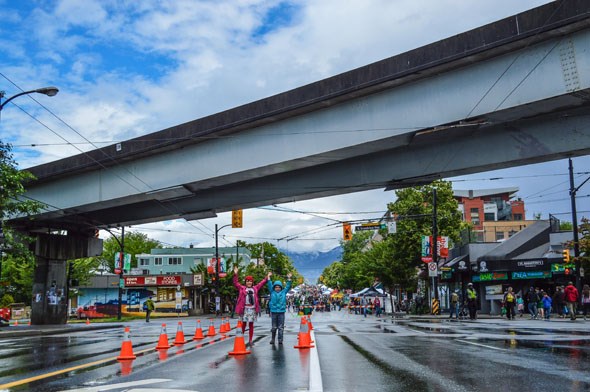 The start of the car-free stretch at Broadway and Commercial.
The start of the car-free stretch at Broadway and Commercial.
This past Sunday, four Â鶹´«Ã½Ó³»neighbourhoods held their annual celebrations. The communities on , , the and got together for massive street parties, bringing together musicians, artisans, non-profit groups and lots of fun activities for people of all ages, along streets closed to automobile traffic for an afternoon. Since moving to the Commercial Drive area, our own family has watched The Drive event grow from a small stretch between 1st Avenue and Venables, to now running as far south as Broadway.
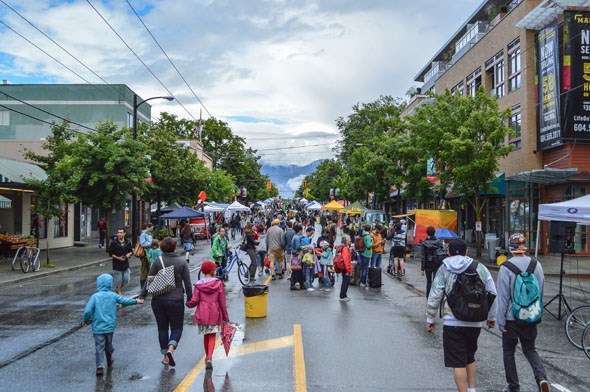 Despite the scattered showers, thousands flocked to enjoy the open street.
Despite the scattered showers, thousands flocked to enjoy the open street.
Car Free Day is a wonderful communal gathering, no matter which part of Â鶹´«Ã½Ó³»you call home. There is a sense of connectivity as you walk through the street, and within moments you are sure to run into people you know. It’s a chance for everyone to come together and celebrate what it is about their neighbourhood they love, and many times catch up with people they haven’t seen in a while. The number of times we were waving across a crowd at people we know, bumping into friends, or seeing our children run and hug their friends is impossible to quantify.
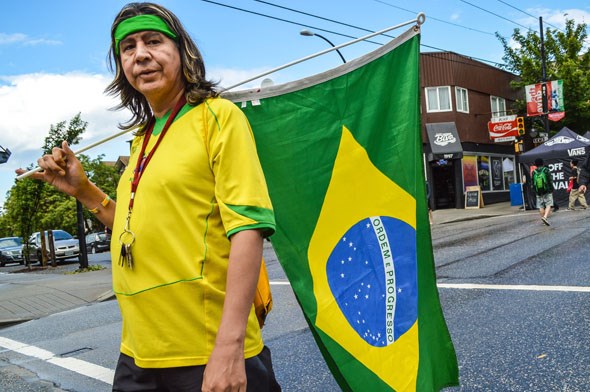 One of the many colourful characters you’ll encounter along the way.
One of the many colourful characters you’ll encounter along the way.
When a city opens the streets to its citizens, they feel a sense of welcoming and belonging as they are free to travel through them without the stress of negotiating with traffic, tight sidewalks and little-to-no space for cycling. Encouraging these meaningful connections not only benefits the health and social lives of the people who live there, but also happens to boost the bottom line of local businesses.
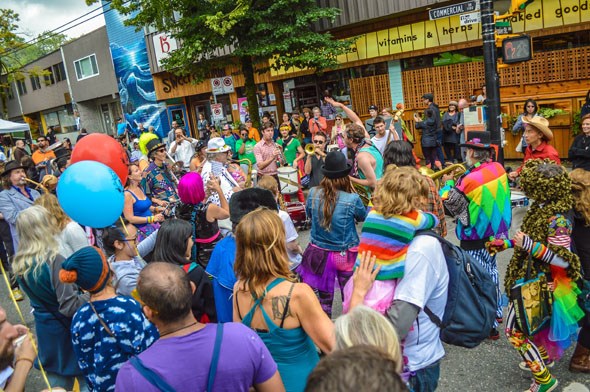 Impromptu dance party with The Carnival Band.
Impromptu dance party with The Carnival Band.
On our travels along The Drive, it became apparent how much local merchants were thriving due to the opening of the street. Many local boutiques had created pop-up shops with their wares on sale for the day, and local artisans had tents throughout the strip where they could sell their handmade creations — something generally reserved for markets or special events — giving them a remarkable amount of exposure. Even hair salons got in on the act, offering quick cuts, styles and even massages right there in the middle of the street.
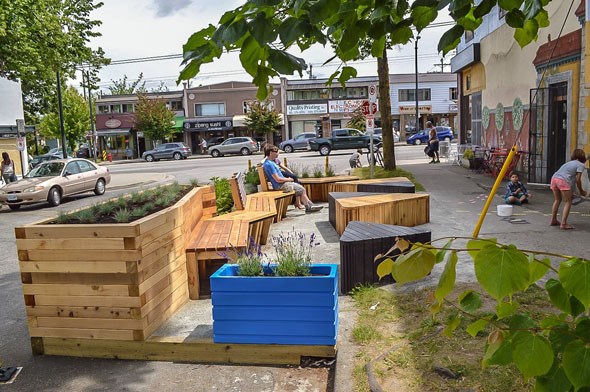 The newly-constructed parklet outside the Chocolaterie de la Nouvelle France at Main and 21st.
The newly-constructed parklet outside the Chocolaterie de la Nouvelle France at Main and 21st.
The biggest impact, though, could be seen in front of the local eateries. Each year, several of the restaurants on The Drive create pop-up patios, which are always full of patrons looking for a spot to rest, grab a bite and even partake in a pint or two of craft beer. The popularity of these temporary public spaces illustrates how parklets and patios can drastically liven up a street. People want to feel connected to their community, not just for a day, but throughout the year. And this reclaimed space provides a gathering place for people of all ages - a spot for chance meetings with friends and neighbours, and somewhere that allows you to feel a part of the urban landscape that surrounds you.
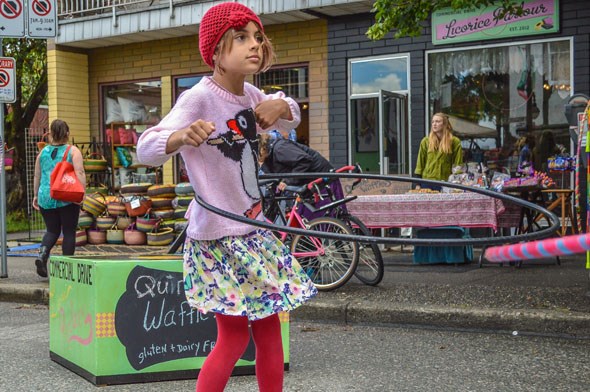 Our daughter taking the time to master her hula hoop technique.
Our daughter taking the time to master her hula hoop technique.
For our own family, the annual festival also (coincidentally) marked the four year anniversary of our decision to sell the family car and live car-free. We have seen Â鶹´«Ã½Ó³»grow and change even in that short amount of time, with the addition of protected cycle tracks, increased transportation options with the arrival of car-share, and a conscious and concerted effort to move away from automobile dependence. When we first began living car-free, it truly seemed like an uphill climb. After four years, we have realized that living where we do affords us the ability to stay nearly as mobile as we were prior to selling our car. We've watched our children become more and more familiar with the people and places in their community by walking, cycling, and transiting to school and their extracurrilcular activities, day in and day out.
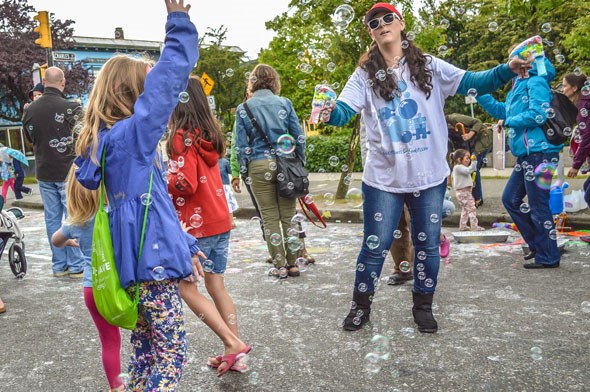 Children playing in the street without fear or restriction. As it should be.
Children playing in the street without fear or restriction. As it should be.
Once a year, Car Free Day offers Vancouverites an opportunity to see their streets in a different light, and experience through them a more connected way of life. One could therefore argue that the next logical step would be to expand on this idea. Other communities throughout North America have already seen the benefits of closing off streets to cars more regularly. In Montreal, they have made their busiest shopping road, , pedestrian-only for the entire summer, holding , a celebration of art and community that runs from May to September. There they have recognized how prosperous this people-only zone will be to not only for businesses, but also increased exposure for local artists, and successful city-wide events like Montreal Pride.
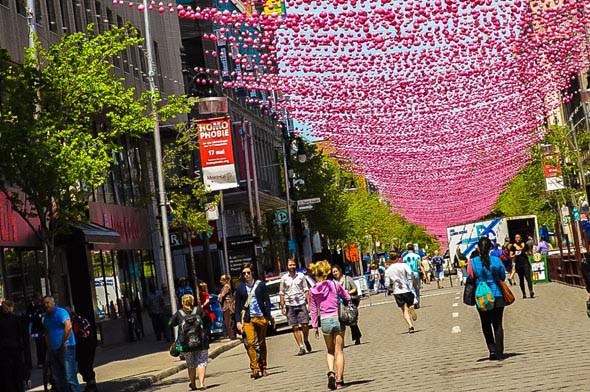 The pedestrianized Saint Catherine Street in Montreal. An absolute joy to experience.
The pedestrianized Saint Catherine Street in Montreal. An absolute joy to experience.
After years of growing popularity for Car Free Days in Vancouver, and the success of Granville weekend closures by , it’s clearly becoming time to expand these one-off, single-day events. We need to recognize that creating open, welcoming, car-free spaces for our citizens is a positive step towards encouraging civic pride, social connectivity, and an understanding that truly world-class cities prioritize life-sized streets, rather than ones designed around the automobile.
***
[To view the full collection of photographs taken by the authors, please click .]
***
Chris and Melissa Bruntlett are the co-founders of , a multi-service consultancy focused on inspiring healthier, happier, simpler forms of urban mobility through words, photography and film. You can find them on Twitter: .


